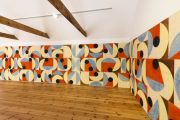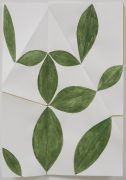Sat 8 September – Sat 15 December 2018
Open Thurs – Sat, 10am – 4pm (or by appointment)
Admission free

This autumn, CAMPLE LINE presents Flying Fox, a new temporary commission and exhibition by artist Louise Hopkins. The first formal presentation of Hopkins’ work in a rural location, Flying Fox brings together a large-scale work of geometric abstraction made specifically for CAMPLE LINE’s gallery spaces and a group of ten new and recent works on paper that have been installed in dialogue with it.
CAMPLE LINE approached Hopkins in July 2017. About to undertake a short residency at Cove Park in Argyll and Bute, she was then scheduled to embark upon the production and installation of Dance Number, her commission for the outside of the Mackintosh Building at The Glasgow School of Art. Familiar within Hopkins’ body of work in respect of its concentrated arrangement of repeated colours and forms, Dance Number was of an architectural scale new to her practice, deriving from questions Hopkins has been increasingly broaching about how abstraction and environment can relate. Hopkins’ project at Cample has developed from her experiences producing Dance Number and opportunities she took at Cove Park to bring her work outside in a more exploratory sense. As she has said, ‘In my work the connection between inside and out has always been important.’
Early in the development of Flying Fox, Hopkins was invited to view archival material at The HALO Trust, Dumfries Museum and Drumlanrig Castle as potential resources she might draw on to connect her practice and her visual language to the area. From the start, however, Hopkins was most attentive to the buildings and structures around Cample Mill and keen to connect her project very directly with the immediate environment. Over the successive days of a February visit, Hopkins spent time positioning large abstract paintings around both the interior of CAMPLE LINE and the grounds outside.
The scale of the paintings, and the effort in lifting them around, necessarily entailed a participatory element that was at times captivating: Hopkins’ new edition, Bridge and Crown resulted from one particular moment that saw Hopkins disappear under (and arguably into) her painting. Hopkins did consider developing a work for outdoors, but ultimately Flying Fox evolved within CAMPLE LINE building. In an early exchange, she offered the following reflection: ‘a linking factor in all my work is that it addresses/responds to context; this might be the context of a catalogue page, a piece of folded paper or of a building or environment.’
The scale of Flying Fox necessitates dynamic viewing and is both encompassing and social, whilst a selection of new and recent works draw attention back to its hand-painted qualities and encourage closer, slower and more personal encounters. Importantly, the smaller framed works engage in dialogue with Flying Fox, connecting it to Hopkins’ existing body of work and her distinctive visual language: Quarters from 2010 prefigures an interest in colour, abstraction, grid and place that ultimately informs Flying Fox. Equally the two paintings on photographic collage, Rosa B and Chandelier, link it to Hopkins’ earlier paintings on patterned fabric. At the same time, like Leaf, they connect us and Flying Fox back to the arboreal world immediately outside the gallery. Others such as Intermediary and Ruby Sapphire delight in pattern and its tactility, and they share a lightness of touch that is evident in Hopkins’ choice of ‘Flying Fox’ as title for both commission and exhibition.
Already Flying Fox is assuming a unique and enigmatic presence of its own. In essence, it is full of shapes much as the walls that dress the exterior of CAMPLE LINE building are full of stone; as Hopkins suggests, ‘one is paint and the other is stone; here they touch each other.’ Arriving at CAMPLE LINE on a bright morning, it is difficult not to connect the pared-down abstract language and palette of Flying Fox with the sight of a cloudless blue sky filling the viaduct arches. Such momentary heightened awareness speaks of Hopkins’ interest in the potential of abstraction to connect us vitally and emotionally to our surroundings, and it is perhaps the promise of Flying Fox as an exhibition – the sense of a sudden uplift, even thrill or elation, offered in its very name.
EXHIBITION BOOKLET

ABOUT LOUISE HOPKINS
Louise Hopkins has exhibited widely overseas and in the UK. In 2017 she completed Dance Number 2017 – a temporary Artist Wall Commission for the exterior of the Mackintosh Building at The Glasgow School of Art.
Her work has been included recently in two important group shows: NOW – Place and Journey, at the Scottish National Gallery of Modern Art, Edinburgh, 2016, and Dévider le réel, at Les Abattoirs, FRAC Midi-Pyrenees, France, in 2015. In 2014 she had a one-person exhibition Black Sea, White Sea as part of GENERATION: 25 years of Contemporary Art in Scotland. In 2007 she was one of 6 artists who represented Scotland at the 52nd Venice Biennale, and in 2005 she had a major one-person exhibition Freedom of Information at The Fruitmarket Gallery in Edinburgh.
Public collections include Jumex Collection, Mexico City; Museum of Contemporary Art, Sydney; the Museum of Modern Art, New York; Musee Cantonal des Beaux-Arts, Lausanne; British Council Collection, London; Arts Council of England, London; Aberdeen Art Gallery, Aberdeen; Les Abattoirs, Toulouse; and the Scottish National Gallery of Modern and Art and Edinburgh City Art Centre, Edinburgh.














